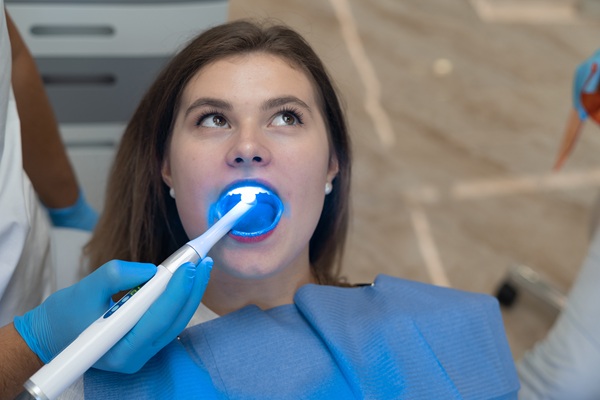 Dental veneers can transform a smile. The American Dental Association defines these as "thin, custom-made shells crafted of tooth-colored materials designed to cover the front side of teeth." These restorations are typically made of porcelain or resin and can last for many years. There are some situations in which veneers need to be replaced; most of these occur as a result of normal wear and tear on the teeth. Patients should seek dental care when noticing certain things about existing restorations.
Dental veneers can transform a smile. The American Dental Association defines these as "thin, custom-made shells crafted of tooth-colored materials designed to cover the front side of teeth." These restorations are typically made of porcelain or resin and can last for many years. There are some situations in which veneers need to be replaced; most of these occur as a result of normal wear and tear on the teeth. Patients should seek dental care when noticing certain things about existing restorations.
Situations in which veneers should be replaced
Because some tooth structure is removed during the veneer procedure, a patient must keep a crown or veneer on the tooth for life. Cosmetic restorations can be replaced when the patient no longer likes the shade of the teeth. They should also be replaced if broken or causing decay in the tooth.
Excessive stains
While porcelain veneers tend to resist staining more than resin ones, both kinds can become discolored over time. If a patient uses tobacco or drinks beverages such as coffee, tea, and red wine, the teeth become stained faster.
Teeth whitening products can be used on a patient's natural enamel to change the shade of the tooth. However, this does not work with veneers. The bleaching material will etch the surface of the porcelain or resin and damage it. Therefore, if a patient wants to change the shade of the teeth, replacement is the only choice.
Cracks or breaks
Biting into hard foods can cause microcracks in a veneer over time. Eventually, the teeth begin looking noticeably cracked from chronic wear. This type of restoration can become weakened over time and break or chip off. This is much more common with resin (composite) veneers, but it can happen with porcelain ones as well.
When a break happens, the dentist usually advises the replacement of one or all the veneers. When coupled with a patient's dislike of the shade of the teeth, replacement becomes the logical option.
Dental decay
When a patient chooses to get veneers placed on the teeth, commitment to good oral hygiene is paramount. The margins around these restorations can become plaque traps if not cleaned properly. When this happens, cavities begin to form under the veneers. This can lead to a loss of a tooth if not treated promptly.
If a dentist detects a cavity under this type of restoration, they will likely recommend replacement. The existing veneer is taken off, the cavity is cleaned out, and a new restoration is placed on the tooth.
Conclusion
For patients wanting to change the size, shape, or shade of the teeth, veneers can be a worthy treatment to consider. When a patient does choose this route, it is important to know when replacement is needed. A healthy, beautiful smile can be treasured for years to come. Patients interested in this cosmetic procedure should discuss it with a dentist to see if it is the right option.
Request an appointment or call Johns Creek Dentistry at 770-623-1427 for an appointment in our Johns Creek office.
Recent Posts
You can cover up imperfections in your teeth with dental veneers, thin shells of porcelain that fit over your teeth, and bond to them. Veneers can last for at least a decade, but they typically need to be replaced occasionally if a dentist must treat underlying tooth decay or gum disease. Veneers can also stain;…
If you are wanting a smile makeover, veneers are an affordable and effective option. As a restorative solution, dental veneers are custom-made shells bonded to the front of your teeth. They are made of thin composite resin or porcelain and attached with dental cement. The veneers share the same color as the natural tooth, but…
Treatments available to improve minor aesthetic issues with your teeth include dental veneers that cover up such imperfections to give your teeth a more uniform appearance. There are two separate treatments that are referred to as veneers, and while they accomplish the same purpose, they have little in common with one another otherwise.Knowing the difference…


